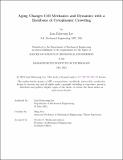Aging Changes Cell Mechanics and Dynamics with a Backbone of Cytoplasmic Crowding
Author(s)
Lee, Lani Dakyoung
DownloadThesis PDF (13.85Mb)
Advisor
Guo, Ming
Terms of use
Metadata
Show full item recordAbstract
Aging is a biological process that is correlated with life-altering and terminal diseases, and while the population of the elderly increases every year, the mechanism behind aging and its physical changes is not fully understood. Many aging studies traditionally focus on molecular-level changes, but much of the physical effect of aging could be better understood in cells, which are the fundamental building blocks of life. In particular, because the cytoplasm comprises approximately 70% of cells and its physical properties strongly influence biological processes, understanding its mechanics provides a more comprehensive description of aging. Using cells from well-established aging mice models, we investigate the morphological and dynamic changes of aging cells and how they relate to the physical state of the cytoplasm. Using particle fluctuation, optical tweezers, and force spectrum microscopy, we demonstrate that aging halves motion inside the cytoplasm due to doubled stiffness, while active forces remain statistically similar. In addition, we take tomograms of cell refractive index that indicate a denser cytoplasm and 3D images that display decreased cell volume, hinting that aging causes a more crowded interior in line with the physical differences we observe. We investigate some key functional differences at the cellular level; confocal images and videos show aged cells spreading larger and rounder, and their motion decreased. 3D morphology and ECM structure, as well as contractility measurements from traction force microscopy indicate a changed cell-environment interaction. We also measure a increased nucleus to cell volume ratio, an important marker in cell biology, that may indicate changes in cell maturity, or even the connection to cancer malignancy. Our results imply a crucial physical mechanism behind cellular-level changes due to aging, helping to reconcile the physical and nonphysical changes investigated in aging literature. This study provides an extensive investigation of the cytoplasm and connects its physical state to the changes in cell mechanics and dynamics observed from aging.
Date issued
2024-05Department
Massachusetts Institute of Technology. Department of Mechanical EngineeringPublisher
Massachusetts Institute of Technology